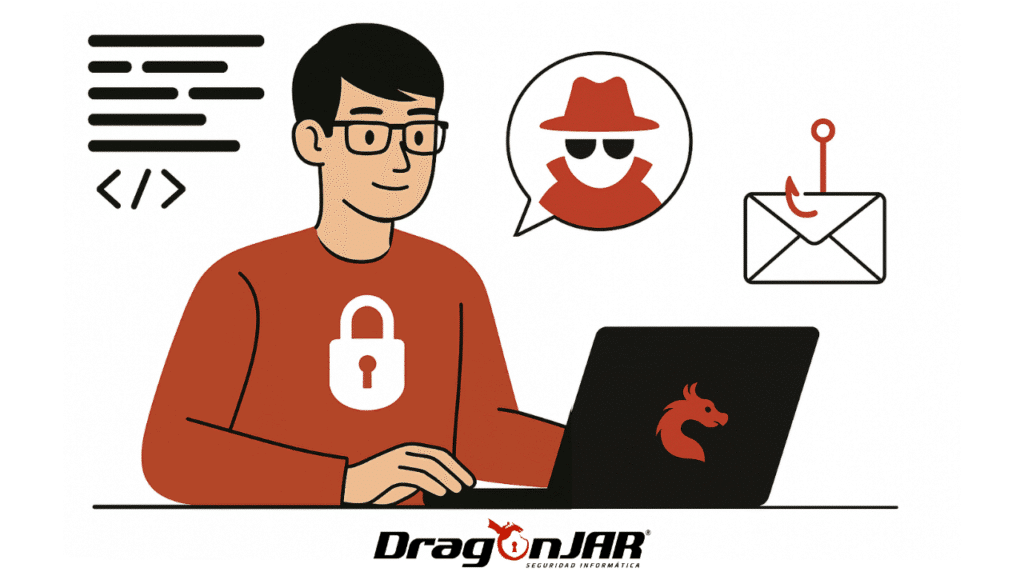Social Engineering Testing
Social engineering is one of the most significant threats in the world of cybersecurity. Through Social Engineering Testing, companies can identify human vulnerabilities and strengthen their defenses against malicious attacks such as phishing, vishing, and more. This article explores how these tests can protect your organization and deliver real value in the fight against cybercriminals.

- What is Social Engineering and Why is it Critical for Your Business?
- What Are the Main Types of Social Engineering Attacks?
- Why Conduct Social Engineering Testing?
- How Does DragonJAR Conduct Social Engineering Testing?
- How to Identify a Social Engineering Attack?
- Frequently Asked Questions about Social Engineering Testing
- Conclusion
Social engineering relies on psychological manipulation to trick individuals into revealing sensitive information or performing actions that compromise security. By targeting the weakest link—human behavior—these attacks can bypass even the most robust technical defenses. Conducting Social Engineering Testing is essential to ensure both security and compliance.
Social engineering preys on trust and misinformation. From a seemingly innocuous phishing email to fraudulent phone calls, attackers use various methods to gain access to personal data and internal systems by exploiting human tendencies.
- Phishing: Emails or messages posing as trusted sources (banks, service providers) that lure recipients into clicking malicious links, downloading infected attachments, or disclosing credentials.
- Vishing (Voice Phishing): Fraudulent phone calls where the attacker poses as technical support or a bank representative to persuade victims to share sensitive information.
- Tailgating (Piggybacking): Unauthorized physical access by following closely behind an authorized person, exploiting workplace courtesy without verifying identity.
- Quid Pro Quo: Offering something valuable—free tech support, rewards, or discounts—in exchange for confidential information, banking on the victim’s eagerness to help or benefit.
- Increase Staff Awareness: Realistic scenarios train employees to spot threats and respond safely.
- Evaluate & Improve Security Policies: Tests reveal procedural gaps, guiding evidence-based policy enhancements.
- Reduce Risk of Breaches: Anticipating attacker strategies minimizes the likelihood of successful incidents.
- Reinforce Security Culture: Hands-on experience fosters shared responsibility and collaboration across teams.
- Realistic Attack Simulations: Controlled phishing, vishing, and other social engineering scenarios mimic real-world attacker behavior to gauge staff susceptibility and policy effectiveness.
- Custom Phishing Campaigns: Tailored to your organization’s identity and context, these campaigns identify high-risk roles and provide targeted training to vulnerable teams.
- Actionable Reporting: Detailed findings, metrics, and recommendations enable immediate corrective measures and policy adjustments based on solid evidence.
- Unsolicited Requests for Personal Data: Emails or messages that claim to be from trusted entities but ask for credentials, financial details, or other sensitive information without clear justification.
- Suspicious Links or Attachments: URLs leading to fake login pages or attachments that may install malware—often disguised as legitimate documents.
- Fraudulent Support Calls: Calls from alleged service providers or IT support, pressuring recipients to reveal private information or install unauthorized software.
A social engineering test evaluates an organization’s vulnerability to human-centric attacks by simulating how an attacker might exploit employees or users to obtain confidential information, such as login credentials or access to critical systems.
Secure Your Future: Elite Cybersecurity Solutions for Modern Businesses
- Email spoofing and phishing campaigns.
- Voice phishing (vishing) with caller ID manipulation.
- Malicious SMS or text message phishing.
- Mass or targeted spear-phishing campaigns.
- Pretexting and deepfake-enhanced social engineering to impersonate trusted personnel.
Attackers exploit trust and weak controls. For example, a fake email or SMS link leads the victim to a fraudulent site that captures credentials or installs malware, compromising personal or financial data.
What is spear phishing and how is it different?
Spear phishing is a highly personalized form of phishing. Unlike broad campaigns, attackers research the target thoroughly—using social media and other sources—to craft believable messages that appear to come from trusted contacts.
How can I test my organization’s defenses?
- Engage experts to perform a professional social engineering test.
- Run simulated phishing campaigns and analyze employee responses.
- Deploy advanced security controls to detect and block social tactics.
- Train staff to recognize and avoid clicking suspicious links or sharing credentials.
Conclusion
- Educate your team to identify malicious emails, calls, and messages.
- Implement robust cybersecurity controls and policies.
- Conduct regular social engineering tests to stay ahead of evolving threats.
Protect your organization with DragonJAR SAS’s Social Engineering Testing services and safeguard your human firewall against the most sophisticated attacks.

Leave a Reply